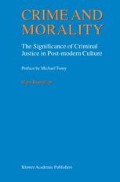Abstract
Secularized, fragmented morality is geared towards the victim. The more graphic the representation of the victim and the more sympathy people can feel, the more chance there is of the victim being recognized and acknowledged as such. In this chapter, I make an effort to illustrate this postulate developed in the previous chapter on the basis of one of the most striking victim resurrections of recent times, the resurrection of the sexually abused child. It is not the nature of the suffering that makes it so striking, but the enormous power this particular victim was able to muster in the limelight of the eighties.
Access this chapter
Tax calculation will be finalised at checkout
Purchases are for personal use only
Preview
Unable to display preview. Download preview PDF.
References
Plus of course the legislation on incest and sex with children that has been passed in the course of time.
The study by Pleck (1989) is also relevant in this connection; it referred to three periods in American history that witnessed a heightened interest in family violence including incest: 1640–1680, 1874–1890 and 1960–1980.
According to Finkelhor (1982), in the past it was mainly “moralists” who focused on the problem. They were the same people who opposed sexual education at school and a humane treatment of sexual offenders.
In Dutch law, incest between adults is not prohibited, but children born of these relations legally have no paternal relatives and bear their mother’s name.
In his final report (1980, p. 50), Melai made the following comment: “I would think that in the event of even the slightest lack of clarity about the harm of sexual relations between adults and juveniles, the benefit of the doubt should go to the protection of the juveniles.”
In this connection, I would like to refer to Kelly (1988), who was opposed to the “revival” of the concept of incest in the. Cleveland Affair and was in favour of a subjective definition of sexual abuse.
Perhaps one indication of the precarious nature of the new relations is that well-educated women more frequently see themselves as victims of sexual harassment than less educated ones (Van Buuren, Wöstmann et al., 1985)
The reverse of “sentimentalization” was the “legalization” of the position of the child, which coincided with a growing interest in the rights of the child (see e.g. Franklin, 1986).
To show how rapidly this emancipation process unfolded, I would like to remind the reader that in the Netherlands it was not. until 1956 that women officially came to have full legal capacity, that up until 1970 the husband was viewed as the legal head of the
For a feminist critique of the collaborating mother, see Wattenberg (1985).
In this connection, various authors have proposed assigning each client a separate therapist in incest cases (see e.g. Jonker, 1987).
In this context, the discussion was opened about the reliability of children’s statements, for example when “anatomical dolls” were used. A comparable debate has started on “hidden memories”, which are discovered later in life at therapeutic sessions.
Compare as regards this point “the power of what comes naturally” in the relations between the sexes (Komter, 1985).
A man’s seed should not go to waste“ see also ”Abuse and Religion. When Praying Isn’t Enough“ (Horton and Williamson, 1988).
Author information
Authors and Affiliations
Rights and permissions
Copyright information
© 2000 Kluwer Academic Publishers
About this chapter
Cite this chapter
Boutellier, H. (2000). The Victimalization of the Sexually Abused Child. In: Crime and Morality. Springer, Dordrecht. https://doi.org/10.1007/978-94-009-0013-4_4
Download citation
DOI: https://doi.org/10.1007/978-94-009-0013-4_4
Publisher Name: Springer, Dordrecht
Print ISBN: 978-90-411-1955-1
Online ISBN: 978-94-009-0013-4
eBook Packages: Springer Book Archive

